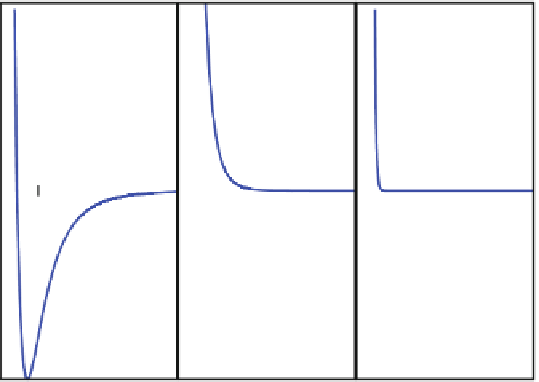Environmental Engineering Reference
In-Depth Information
∂
H
∂
p
i
=
p
i
m
,
r
i
=
(1)
∂
H
∂
r
i
=−∇
p
i
=−
U
ij
=
F
i
,
(2)
)
p
i
where the Hamiltonian of the system is given by
H
=
(
1
/
2
m
·
p
i
+
U
ij
,
j
=
i
U
ij
is the force acting on particle
i
due to intermolecular
and
F
i
=−∇
interactions,
is the gradient operator, and the dot represents time derivative. Here
U
ij
is the interaction potential defined as
∇
r
ij
n
2
n
r
ij
U
ij
(
r
ij
)
=
4
ʵ
−
ʲ
,
(3)
where
r
ij
represents the nearest separation between particle
i
and wall parti-
cle/particle
j
, ˃
is the diameter for both, the fluid particles and particles conforming
the wall,
ʵ
is the potential depth,
n
is a positive integer, and
ʲ
={
,
}
. To study the
interaction effects on particles diffusion, we consider three different potentials (see
Fig.
2
), (a) the classic Lenard-Jones potential (CLJ),
n
0
1
=
6 and
ʲ
=
1
;
(b) a soft
Lennard-Jones potential (SLJ),
n
=
6 and
ʲ
=
0
;
and (c) a hard repulsive potential
(HLJ),
n
=
36 and
ʲ
=
0
.
Note that to speed up the code, we consider
U
ij
=
0for
r
ij
>
3
˃
.
We confine the fluid with a wall made up of spherical particles fixed in space (see
Fig.
1
) and interacting with the fluid particles by means of the interaction potential
r
c
where
r
c
is a cut-off distance defined as
r
c
=
1.0
(a)
(b)
(c)
0.8
0.6
0.4
0.2
r
*
r
*
r
*
0.0
1
.0
1.5
2.0
2.5
1.0
1.5
2.0
2.5
1
.0
1.5
2.0
2.5
-0.2
-0.4
-0.6
-0.8
-1.0
Fig. 2
(Color online) Schematics of the three potentials studied.
a
The classic Lenard-Jones poten-
tial (CLJ),
n
=
6and
ʲ
=
1;
b
a soft Lennard-Jones potential (SLJ),
n
=
6and
ʲ
=
0
;
and
c
a
Here
r
∗
=
hard repulsive potential (HLJ),
n
=
36 and
ʲ
=
0
.
r
/˃
is a reduced variable





















































































































Search WWH ::

Custom Search